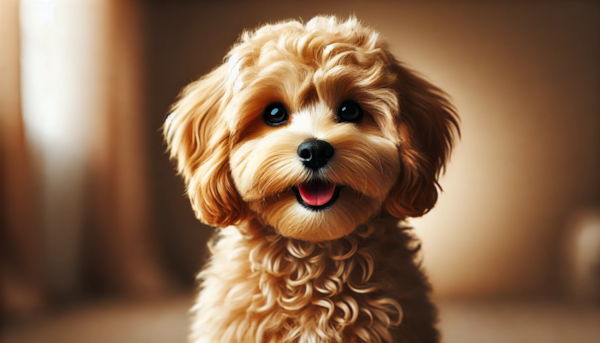
Looking for a cute, low-shedding dog that’s perfect for any household? The tan Maltipoo could be exactly what you need! This sweet little dog, a cross between a Maltese and a Poodle, is known for its fluffy tan coat, playful personality, and how well it gets along with just about everyone—from kids to seniors. They’re not just adorable, but their hypoallergenic coat also makes them a great choice if you have mild allergies.
In this guide, we’ll cover everything you need to know about the tan Maltipoo, from grooming tips and training advice to finding the right one for your home and family.
Table of Contents
What Is a Tan Maltipoo?
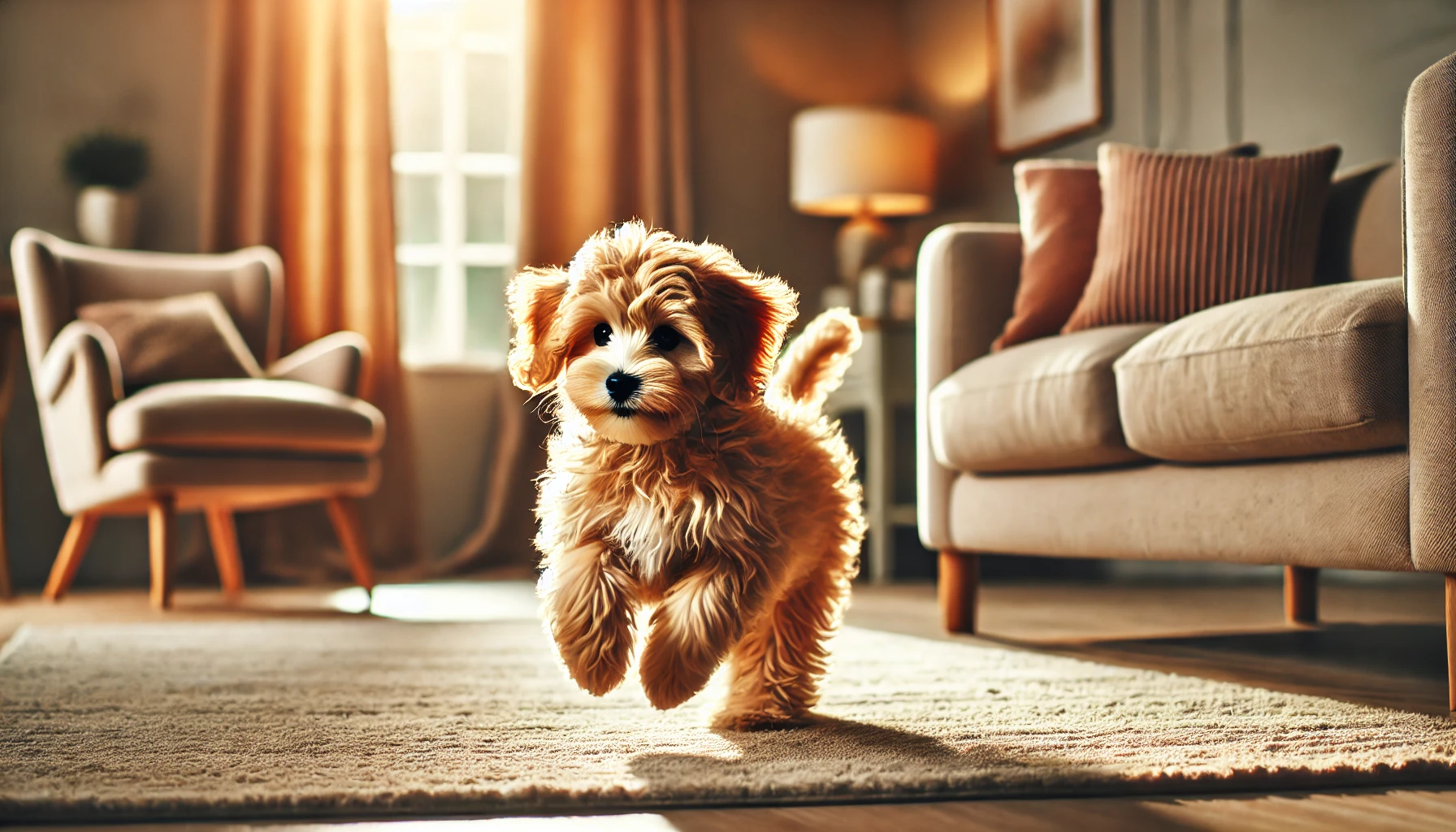
AI image of a tan Maltipoo puppy: generated with ChatGPT.
So, what exactly is a tan Maltipoo? Simply put, it’s an adorable mix between a Maltese and a Poodle, known for its light to deep caramel-colored coat. This hybrid breed combines the best traits from both parent dogs, giving you a playful, friendly, and low-shedding companion that’s perfect for any type of home.
Tan Maltipoos usually weigh between 5 to 20 pounds depending on the size of the Poodle parent, and they typically live for about 12-15 years. Their coats are soft and either wavy or curly, which means they don’t shed much—great news if you’re allergic to dog hair! While their coat color can vary from pale tan to a richer caramel, it may also lighten slightly as they age, especially around their face and paws.
Why are they so popular? Well, aside from their cute appearance, Maltipoos are known for being super affectionate and easy to train. They love spending time with their owners and can adapt to almost any living situation, whether you live in an apartment or a house with a yard.
Quick Stats:
- Size: 5–20 pounds
- Lifespan: 12–15 years
- Coat: Wavy or curly, soft, and low-shedding
- Temperament: Friendly, affectionate, and playful
RELATED: The Forever Young and Sweet Maltipoo
How Is a Tan Maltipoo Achieved? (Genetics and Coat Color)
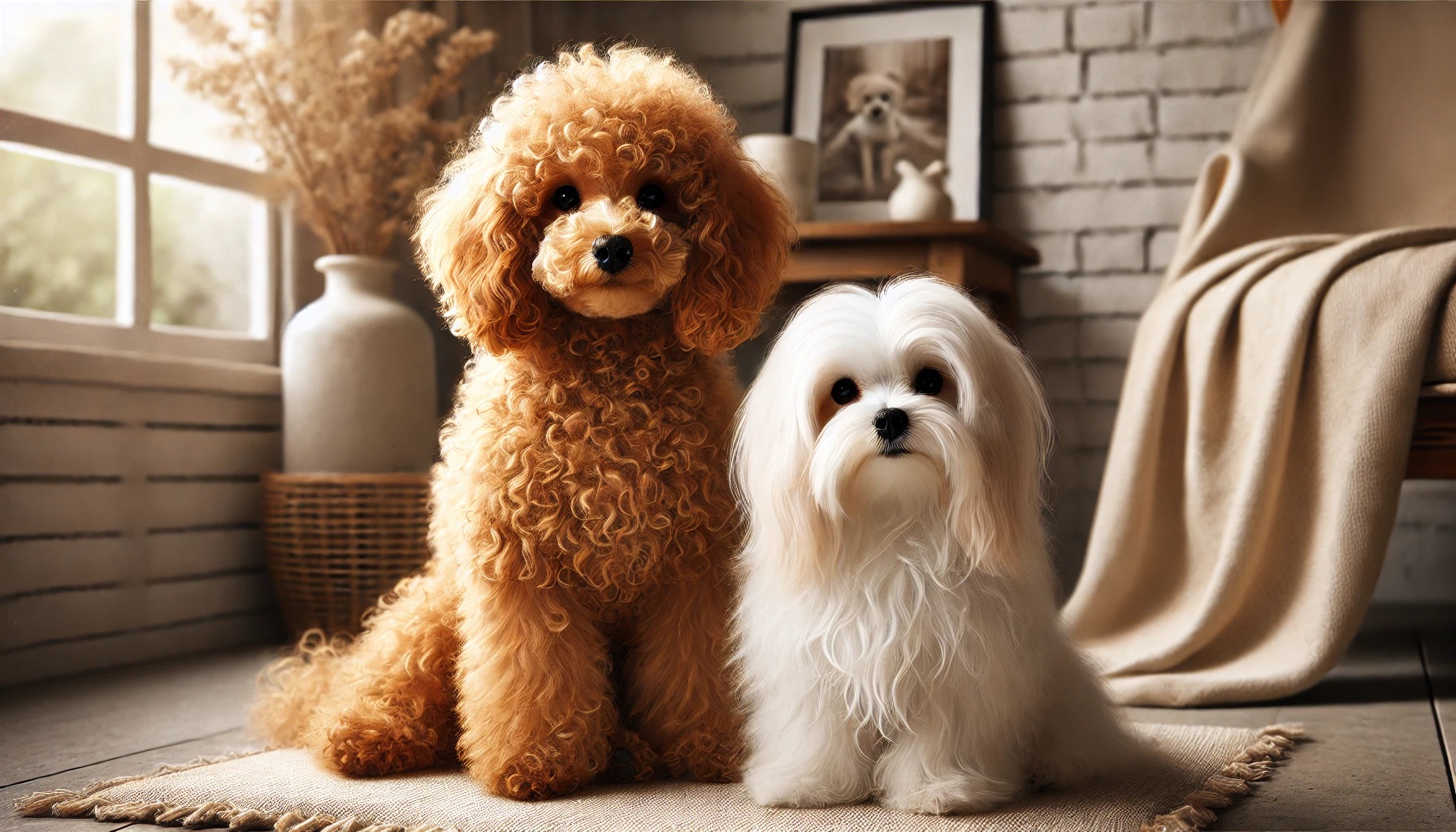
AI image of a tan Poodle next to a Maltese: generated with ChatGPT.
Ever wondered how a tan Maltipoo gets its unique coloring? The tan coat is the result of specific genetic traits passed down from the Poodle parent. Let’s break it down.
The Maltipoo is a designer dog breed, which means it’s a cross between a Maltese and a mini or toy Poodle. While Maltese dogs are typically white, Poodles come in a wide variety of colors, including apricot, cream, and tan. It’s the Poodle’s genes that are responsible for the tan coloring in a Maltipoo.
The Role of Poodle Genes: Poodles carry genes for many colors, and tan is one of the more common shades that appears when they’re mixed with a Maltese. Specifically, the gene responsible for tan, apricot, or caramel coats is often a recessive gene. For this color to appear, both parents (in this case, especially the Poodle) need to carry the gene that produces a tan or apricot coat.
How the Color Develops:
- Puppy Stage: When tan Maltipoos are born, their coat may look deeper and more saturated. However, as they grow, the color often lightens a bit, particularly around the face and paws.
- Adult Stage: By the time your tan Maltipoo reaches adulthood, their coat will usually be lighter but still keep that warm tan hue that makes them so attractive. This fading happens because of what’s known as the “fading gene,” which is common in Poodles.
RELATED: Everything You Need to Know About Puppy Color Changes
Fun Fact: The Poodle’s apricot color was officially recognized by the American Kennel Club (AKC) in 1898. This color is believed to come from a combination of recessive genes, including blue, brown, and silver.
So, while the Maltese parent typically contributes its adorable, hypoallergenic white coat and playful personality, the Poodle brings the variety of coat colors—like tan—that make this breed so unique and popular.
RELATED: Complete Guide to All Maltipoo Colors
Personality and Temperament of a Tan Maltipoo
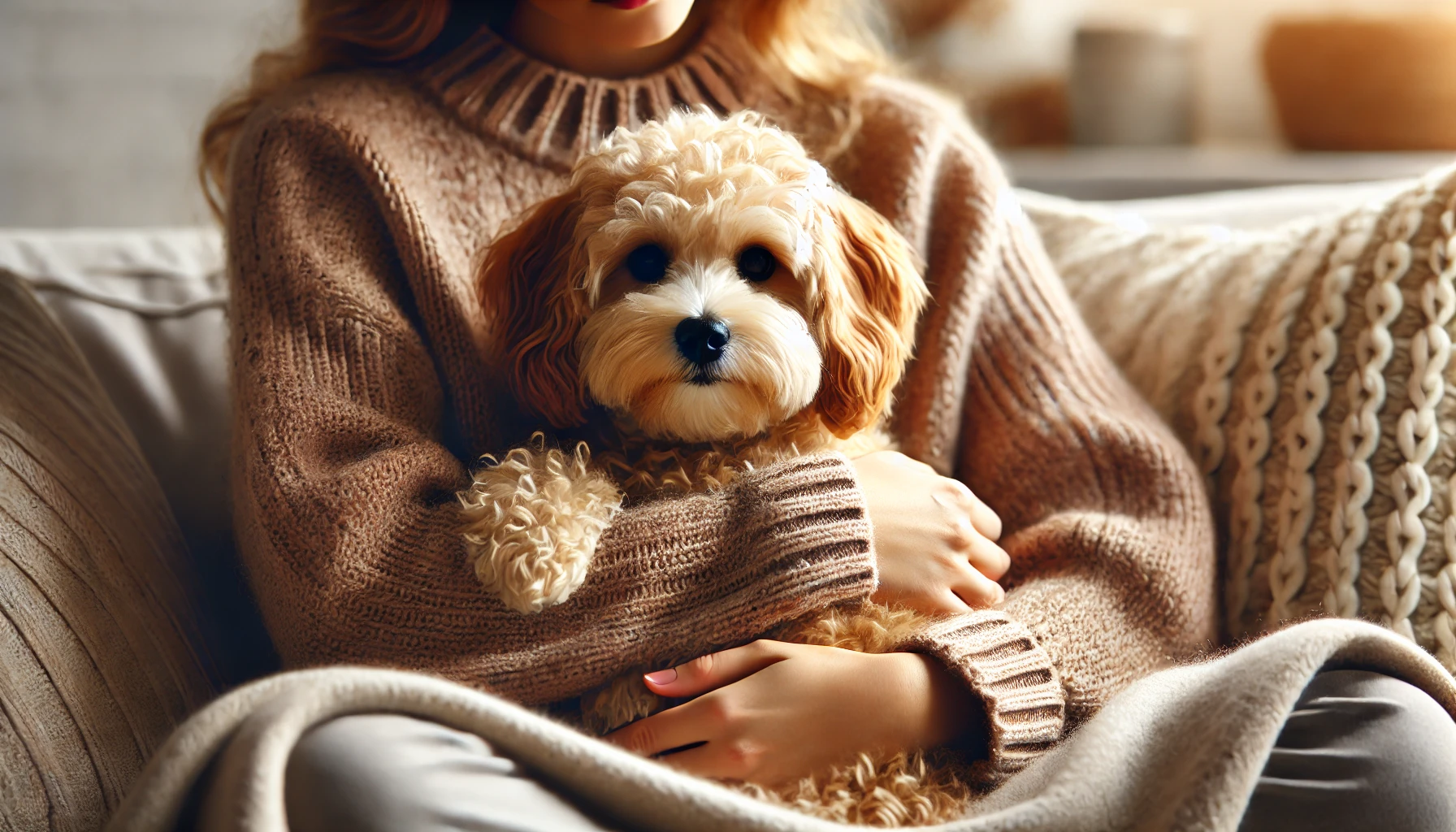
AI image of a tan Maltipoo dog: generated with ChatGPT.
Now that you know how a tan Maltipoo gets its unique color, let's talk about their personality. Spoiler alert: they’re as sweet and loving as they look! This designer breed combines the best traits of the Maltese and the Poodle, resulting in a friendly, affectionate, and smart little dog that fits right into family life.
Affectionate: Tan Maltipoos are known for their loving nature. They thrive on human interaction and love to be close to their owners, whether that means curling up on your lap or following you around the house like a shadow. They tend to form strong bonds with their families and make perfect companions for both individuals and families.
Playful and Energetic: Despite their small size, tan Maltipoos have plenty of energy to go around! They love playtime, whether it's a game of fetch or simply running around the house with their favorite toy. Regular walks and play sessions help them burn off that energy and keep them mentally stimulated.
Great with Kids and Pets: Their gentle temperament means they typically get along well with kids and other pets. Tan Maltipoos are not aggressive, and their playful, easygoing nature makes them a great fit for multi-pet households. Just make sure to supervise playtime with very young children to avoid accidents due to the dog’s small size.
Highly Intelligent: Thanks to their Poodle genes (Poodles are ranked as the second most intelligent breed in the world), tan Maltipoos are very smart and quick to pick up on training. They respond well to positive reinforcement and love to learn new tricks. This intelligence also means they need mental stimulation, so keep them busy with puzzle toys or games to prevent boredom.
Loyal and Protective: Despite their small stature, tan Maltipoos are often quite protective of their families. They’ll bark to alert you when someone’s at the door or when they sense something unusual.
Pro Tip: Tan Maltipoos love attention, but they can also suffer from separation anxiety if left alone for long periods. If you’re away often, consider hiring a dog walker or arranging for a dog-sitter to keep your pup happy and stress-free.
RELATED: Are Maltipoos Smart?
Grooming Needs for a Tan Maltipoo
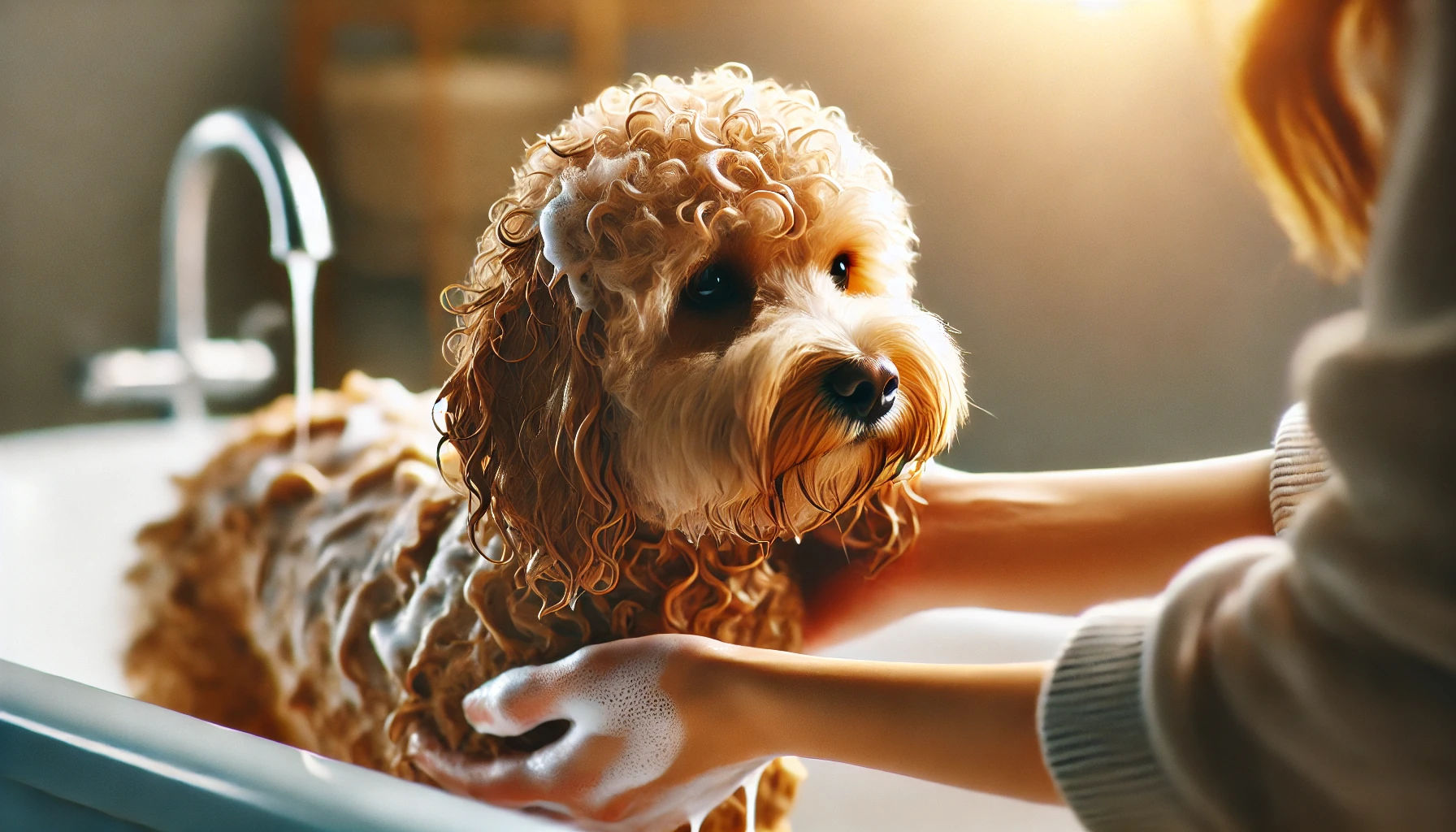
AI image of a tan Maltipoo adult dog: generated with ChatGPT.
Taking care of a tan Maltipoo's coat is essential to keep it soft, tangle-free, and looking its best. Since these pups have a low-shedding coat, grooming is easier than with other breeds, but it still requires regular attention. Here’s what you need to know about grooming your tan Maltipoo to keep them looking and feeling great.
Regular Brushing: The tan Maltipoo’s coat is either wavy or curly, which can lead to matting if not properly maintained. To prevent tangles and keep their coat smooth, it’s important to brush them 2–3 times a week using a slicker brush or a comb designed for curly-coated dogs. Regular brushing also helps distribute the natural oils in their coat, keeping it healthy and shiny.
Bathing: Tan Maltipoos don’t need frequent baths—once every 4-6 weeks is enough. Use a gentle, dog-friendly shampoo that’s free of harsh chemicals to protect their sensitive skin and maintain the natural oils in their fur. Be sure to dry their coat thoroughly, as dampness can lead to skin irritation.
Professional Grooming: It’s a good idea to schedule professional grooming every 6–8 weeks. This will keep their coat at a manageable length and prevent overgrowth, especially around the face, paws, and ears. You can also ask your groomer to trim around the eyes to avoid tear stains, which are common in light-colored dogs like tan Maltipoos.
Nail Trimming and Ear Care: Regularly trim your tan Maltipoo’s nails—usually every 3-4 weeks—to keep them comfortable and prevent injury. Don’t forget to check their ears for wax buildup or signs of infection. Use a vet-recommended ear cleaner to gently clean their ears and keep them healthy.
Pro Tip: Introduce grooming early, when your Maltipoo is still a puppy. This helps them get used to the process and prevents future grooming struggles.
RELATED: 20 Pros and Cons of Owning a Maltipoo
Training and Exercise Needs for a Tan Maltipoo
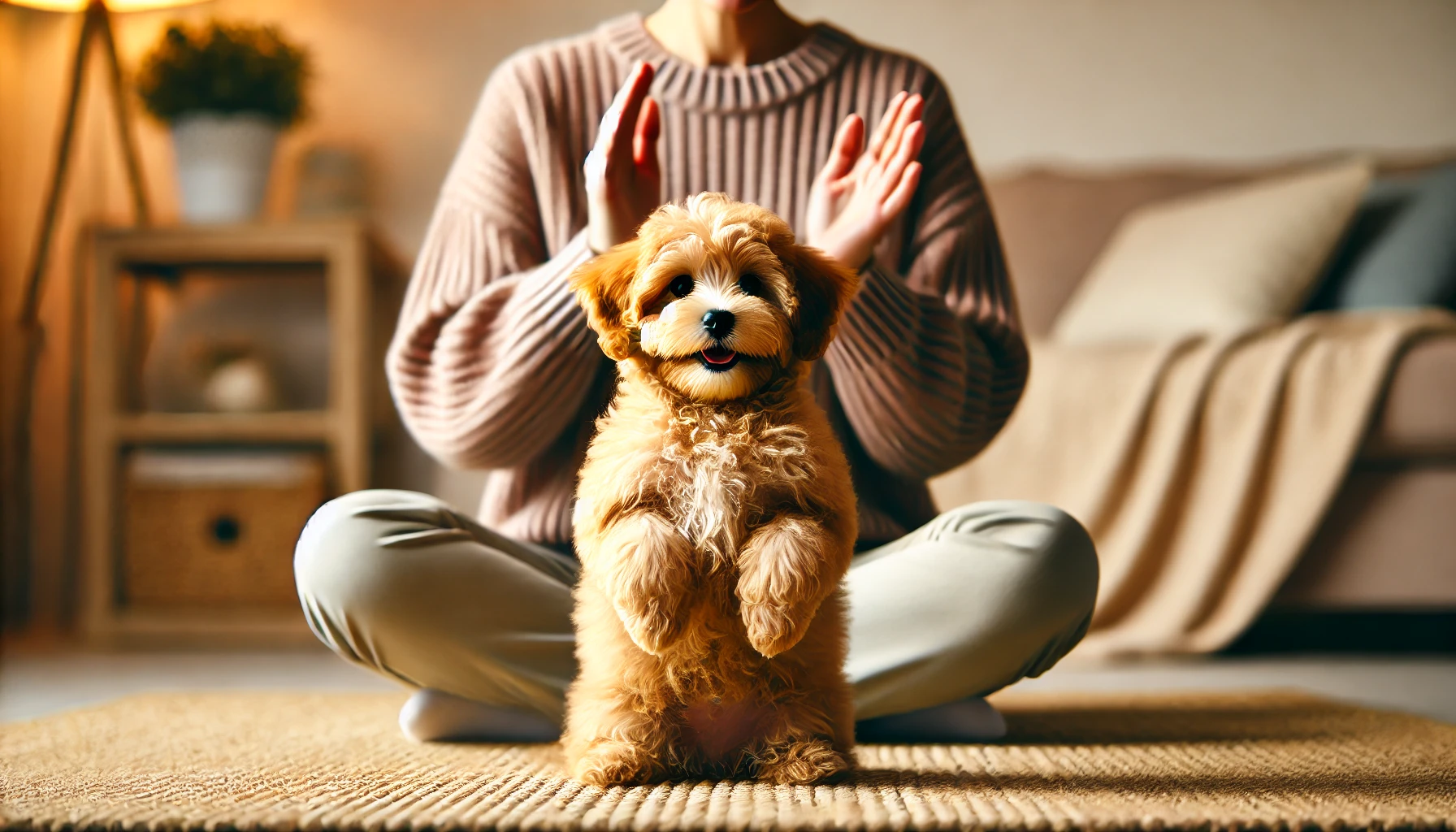
AI image of a tan Maltipoo puppy: generated with ChatGPT.
Tan Maltipoos are small, but don’t let their size fool you—they’re packed with energy and love a challenge! These little dogs thrive when they’re mentally and physically engaged, which means both training and exercise are key to keeping them happy and healthy.
Training a Tan Maltipoo
Thanks to their Poodle lineage, tan Maltipoos are highly intelligent and easy to train. They respond best to positive reinforcement—treats, praise, and plenty of affection (petting, belly rubs). Start with basic commands like “sit,” “stay,” and “come.” Once they’ve mastered those, you can move on to more advanced tricks. Keeping training sessions short and fun (around 10–15 minutes) helps hold their attention without overwhelming them.
Maltipoos do well when they know what to expect. Establish a consistent routine for training and stick to it. This will make learning easier and quicker for them. Remember to be patient—although they’re smart, every dog learns at its own pace!
It’s also important to start socializing your tan Maltipoo early. Expose them to different environments, people, and other pets while they’re still puppies. This helps prevent behavioral issues like anxiety or aggression as they grow older.
Exercise Needs
Even though they’re small, tan Maltipoos need daily exercise to burn off energy. Aim for at least 20–30 minutes of activity each day, whether it’s a walk, a game of fetch, or just some playtime around the house. Interactive toys that challenge their intelligence—like puzzle feeders or toys that make them “work” for treats—are great for keeping their brains engaged too.
Pro Tip: Maltipoos love attention, so make sure you’re a part of their playtime and exercise. Whether it’s a quick game of tug-of-war or a walk around the block, they’ll appreciate the interaction and bonding time.
Don’t forget about their mind! Because tan Maltipoos are so smart, they can get bored if they’re not mentally challenged. Rotate their toys regularly, introduce new tricks to their routine, and use interactive games to keep them sharp.
RELATED: How to Train a Puppy
Reserving or Buying a Tan Maltipoo
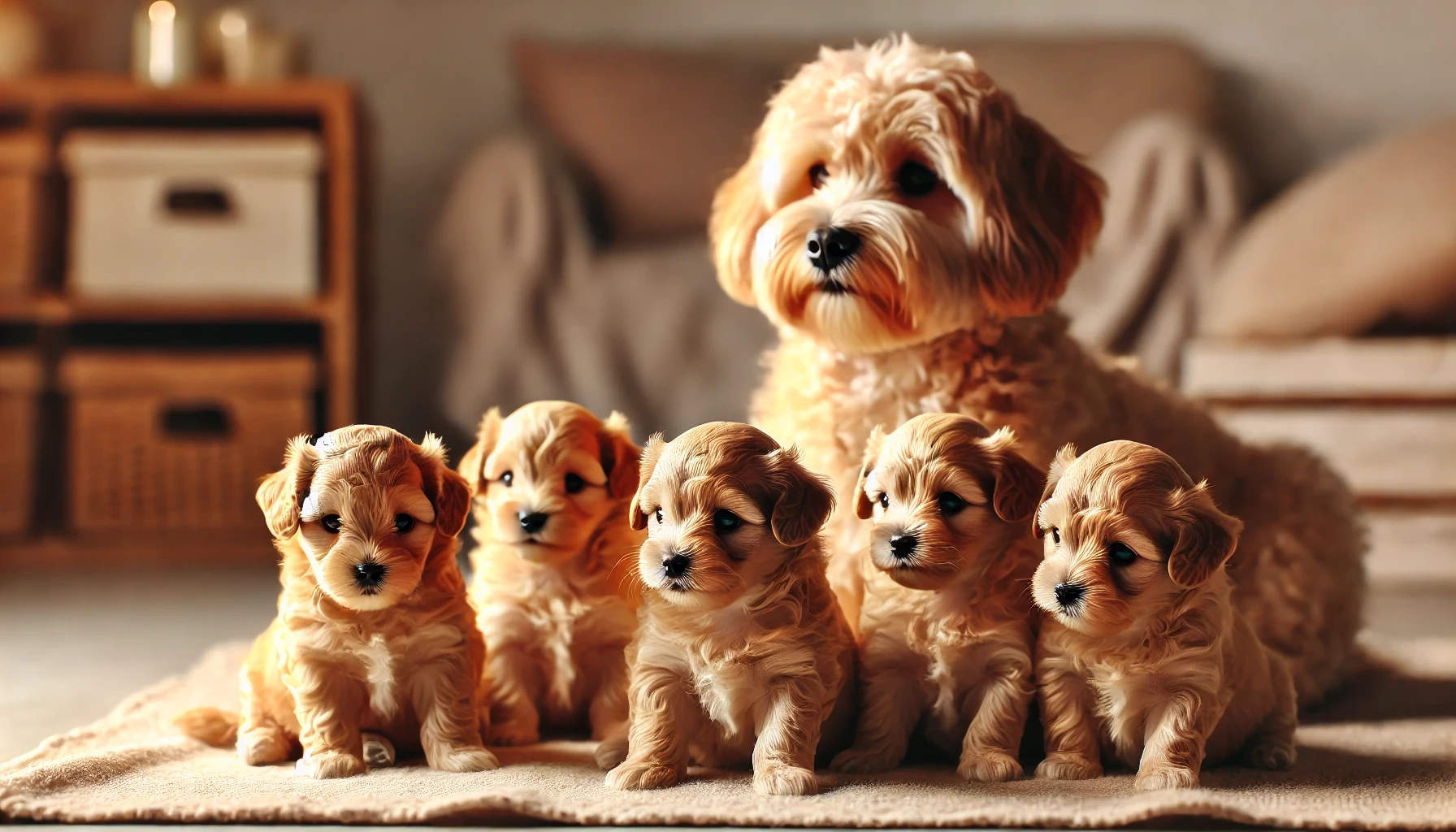
AI image of tan Maltipoo puppies: generated with ChatGPT.
If you’ve decided that a tan Maltipoo is the perfect dog for you, the next step is figuring out how to bring one home. Whether you’re looking to reserve from a rescue or buy from a breeder, there are a few important things to keep in mind.
Buying from a Reputable Breeder
If you’re set on buying a tan Maltipoo puppy, make sure to work with a responsible breeder who prioritizes the health and well-being of their dogs. A good breeder will provide you with health clearances for both the Maltese and Poodle parents, ensuring that the puppy comes from a healthy bloodline.
Prices for tan Maltipoos can vary, but you should expect to pay between $1,000 to $4,000, depending on the breeder’s reputation, the puppy’s lineage, and location. If the price seems too good to be true, it might be a red flag—make sure to do your research.
Questions to Ask a Breeder:
- Can you provide health clearances for the puppy’s parents?
- Are the puppies socialized?
- What vaccinations and health checkups has the puppy received so far?
Reserving a Tan Maltipoo
Reserving a dog is a wonderful way to provide a loving home to a pet in need. While tan Maltipoos might be a bit harder to find at shelters or rescues compared to breeders, it’s still possible. Many rescues specialize in small or designer breeds, and Maltipoos sometimes end up in these shelters through no fault of their own. You can start by checking local rescues, breed-specific organizations, or nationwide databases.
Reservation fees are generally much lower than buying from a breeder, usually ranging from $200 to $500, and often include vaccinations, spaying/neutering, and sometimes even microchipping.
Pro Tip: If you’re open to slightly older dogs, check with local rescues for any adult tan Maltipoos who may be looking for a new home. These dogs are often already trained and socialized.
RELATED: See available Tan Maltipoo puppies for sale at Premier Pups
Why Tan Maltipoos Make Great Pets
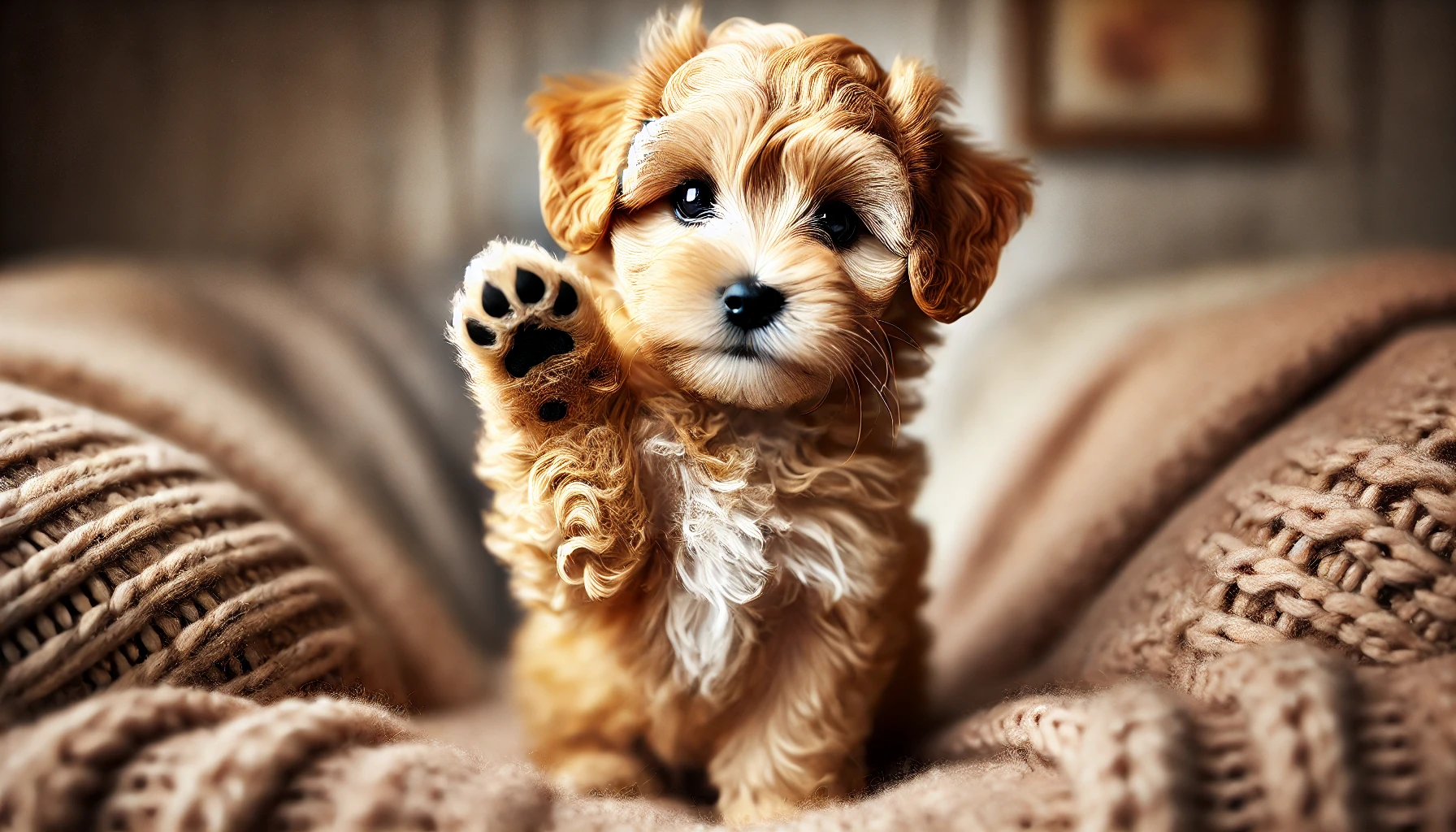
AI image of a tan Maltipoo puppy: generated with ChatGPT.
Now that we’ve covered everything from their adorable appearance to care, training, and how to bring one home, it’s easy to see why tan Maltipoos are so popular. These small, playful dogs offer the perfect mix of intelligence, affection, and low-maintenance care. Here’s a quick recap of why a tan Maltipoo might be the perfect fit for you:
- Low-Shedding and Hypoallergenic: Tan Maltipoos are known for their low-shedding coats, which makes them ideal for people with mild allergies. Regular brushing and occasional grooming are enough to keep their soft, curly fur looking fresh without filling your home with dog hair.
- Friendly and Affectionate: These dogs love their humans more than anything! Tan Maltipoos thrive on attention and quickly form strong bonds with their families. Whether you’re single, have kids, or live with other pets, a Maltipoo will happily fit into your home.
- Easy to Train: Thanks to their Poodle lineage, tan Maltipoos are highly intelligent and easy to train. They pick up commands quickly, making them a great choice for first-time dog owners or anyone looking for a smart, responsive companion.
- Adaptable and Great for Any Living Situation: Whether you live in a small apartment or a house with a yard, Maltipoos adapt easily to different living environments. They don’t need tons of space, but they do love their daily exercise and playtime.
- Long Lifespan: With proper care, tan Maltipoos can live 12-15 years, giving you a long-lasting companion to share many happy moments with.
If you’re looking for a dog that’s both playful and loves to snuggle, the tan Maltipoo offers the best of both worlds!
Learn about other popular Maltipoo colors:
What You Need to Know About White Maltipoos
A Guide to the Lovely Apricot Maltipoo
A Guide to Black and White Maltipoos
Everything You Need to Know About Brown Maltipoos
An Introduction to Red Maltipoos
All About Chocolate Maltipoos
Meet The Unique Black and Brown Maltipoo
Scroll down to see FAQs about Tan Maltipoos.
What To Read Next
All About Chocolate Maltipoos
An Introduction to Red Maltipoos
Frequently Asked Questions
What is a tan Maltipoo? A tan Maltipoo is a crossbreed between a Maltese and a Poodle, known for its light caramel-colored or apricot coat. Their color comes from the Poodle parent, as Poodles carry genes for a wide variety of colors, including tan.
Are tan Maltipoos hypoallergenic? Yes, Maltipoos are considered hypoallergenic because they inherit their low-shedding coat from the Poodle parent. While no dog is entirely hypoallergenic, tan Maltipoos shed very little, making them a good option for allergy sufferers.
Do tan Maltipoos' coats change color as they age? Yes, it's common for tan Maltipoos to experience some coat color changes as they mature. Many puppies start with a darker tan coat that lightens as they grow older, especially around their face and paws.
How much exercise does a tan Maltipoo need? Tan Maltipoos are small dogs, so they don’t require intense exercise. However, they are energetic and need around 20–30 minutes of exercise daily, which can include walks, playtime, or indoor games.
Are tan Maltipoos easy to train? Yes, Maltipoos are highly intelligent and eager to please, which makes them relatively easy to train. They respond best to positive reinforcement, so training with treats and praise is effective.
How big do tan Maltipoos get? Most tan Maltipoo adults weigh between 5 to 20 pounds and stand about 8 to 14 inches tall, depending on whether they are bred with a toy or miniature Poodle.
Are tan Maltipoos good with children and other pets? Yes, tan Maltipoos are known for being friendly and gentle. They get along well with children and other pets, though it's important to supervise play with very young children.
What health issues are common in tan Maltipoos? Maltipoos can inherit health problems from their parent breeds, such as patellar luxation (knee issues) and dental problems.
How often should you groom a tan Maltipoo? Tan Maltipoos need regular grooming due to their wavy or curly coats. They should be brushed 2–3 times a week to prevent matting, with a professional grooming session every 6–8 weeks to maintain coat health.
How long do tan Maltipoos live? Tan Maltipoos have a lifespan of 12 to 15 years with proper care, though some may live even longer. Regular vet check-ups, a good diet, and grooming are essential for a long and healthy life.




